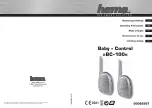
English
English
EN-50
EN-51
Operating the device
Operating the device
C
C
The device categorises the blood pressure
readings according to the 1999 guidelines of the
World Health Organisation (WHO). You can deter-
mine the classification after each measurement
using the triangle in the display and the colour
fields next to the display.
The WHO classification is stored along with the measured values
and both can be recalled from the memory.
Depending on age, weight and general health, the blood pres-
sure values can be different. Only a doctor can determine the
right blood pressure range for you and assess whether your
blood pressure has reached a dangerous level for you. Discuss
your blood pressure values with your doctor.
The pulse pressure – not to be confused with the pulse beat
– provides an indication of the elasticity of the blood vessels.
A stiff system of vessels can have a negative effect on the car-
diovascular system. Studies show that the cardiovascular risk
increases if the pulse pressure value is permanently higher than
65 mmHg.
The heart works in two phases, the contraction phase (expulsion
phase, systole) and the relaxation phase (filling or resting phase,
diastole). The pressure difference between systole and diastole
is called the pulse pressure or pulse amplitude. The higher the
pulse pressure, the stiffer your vessels are thought to be.
11. Classification of the measured values (WHO)
12. Pulse pressure
Classification
Systolic pressure
= top value
mmHg
Diastolic pressure
= bottom value
mmHg
Stage 3 hypertension
≥ 180
≥ 110
Stage 2 hypertension
160-179
100-109
Stage 1 hypertension
140-159
90-99
High-normal
130-139
85-89
Normal
120-129
80-84
Optimal
< 120
< 80
High pulse pressure
Above 65 mmHg
Increased pulse pressure
55 to 65 mmHg
Normal pulse pressure
Below 55 mmHg
If your pulse pressure is permanently above 55 mmHg, consult
your doctor.
If the device detects irregular pulses during the
measurement, the symbol is displayed once
the measurement is complete.
This can be triggered by cardiac arrhythmias,
movement, talking or even by deep breathing.
The symbol is stored with the respective meas-
urement.
13. Irregular pulses and cardiac arrhythmia
A more frequent appearance of the symbol may indicate cardiac
arrhythmia and must be discussed with your doctor! Measure-
ment results accompanied by irregular pulses should therefore
Содержание VISOMAT COMFORT 2-
Страница 66: ......
















































